Charles E W Bean, Diaries, AWM38 3DRL 606/252/1 - 1918 - 1935 - Part 1
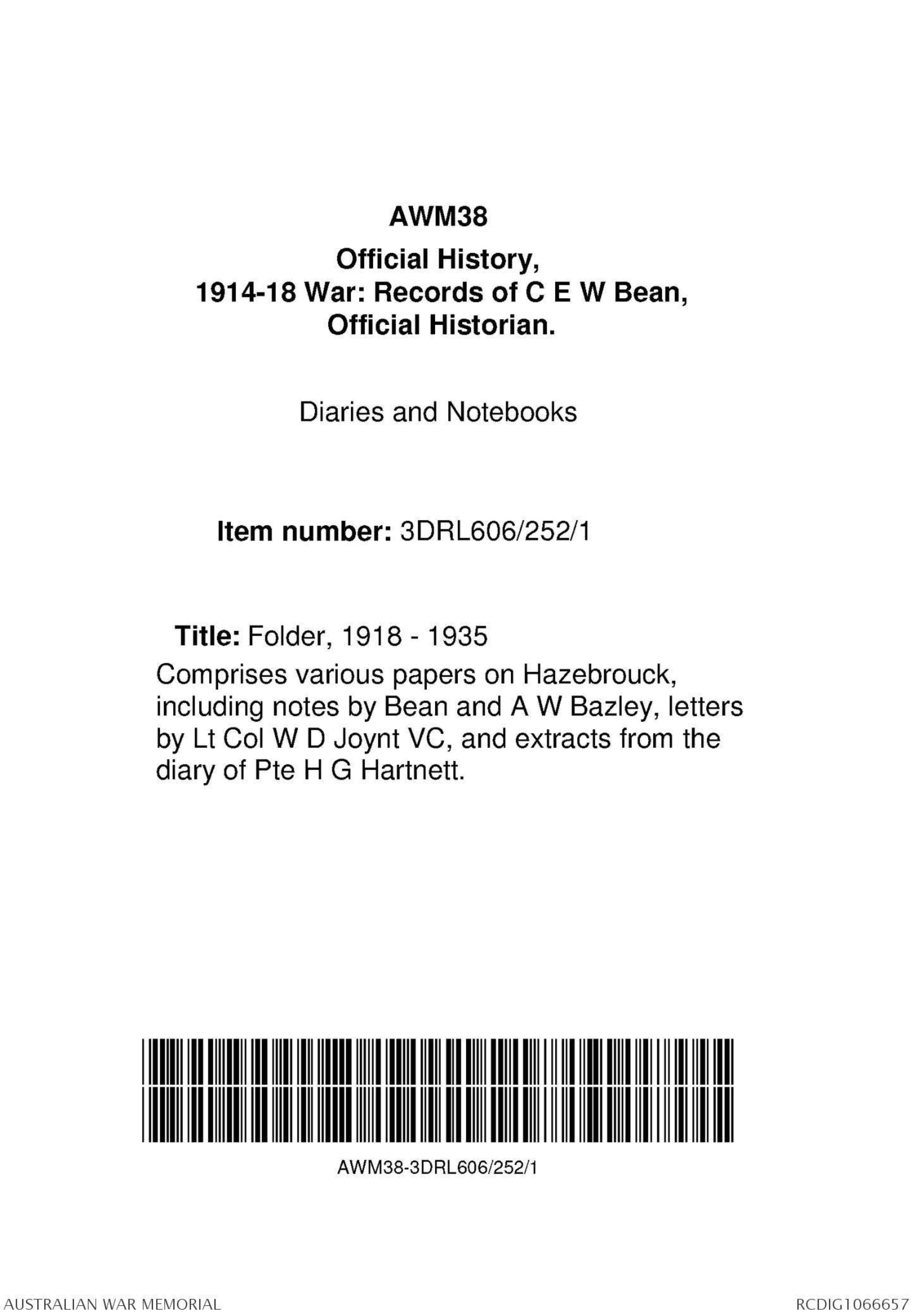
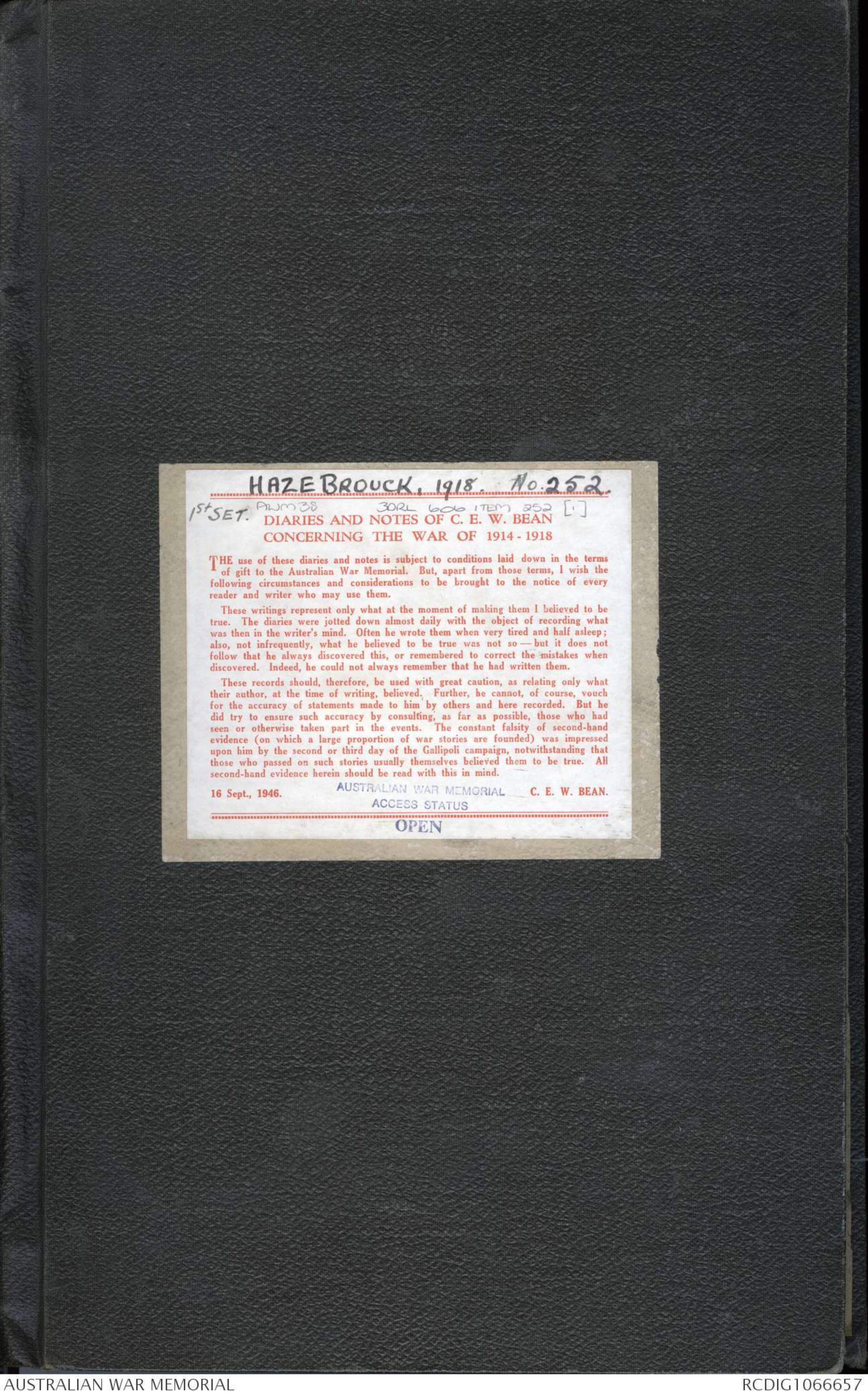
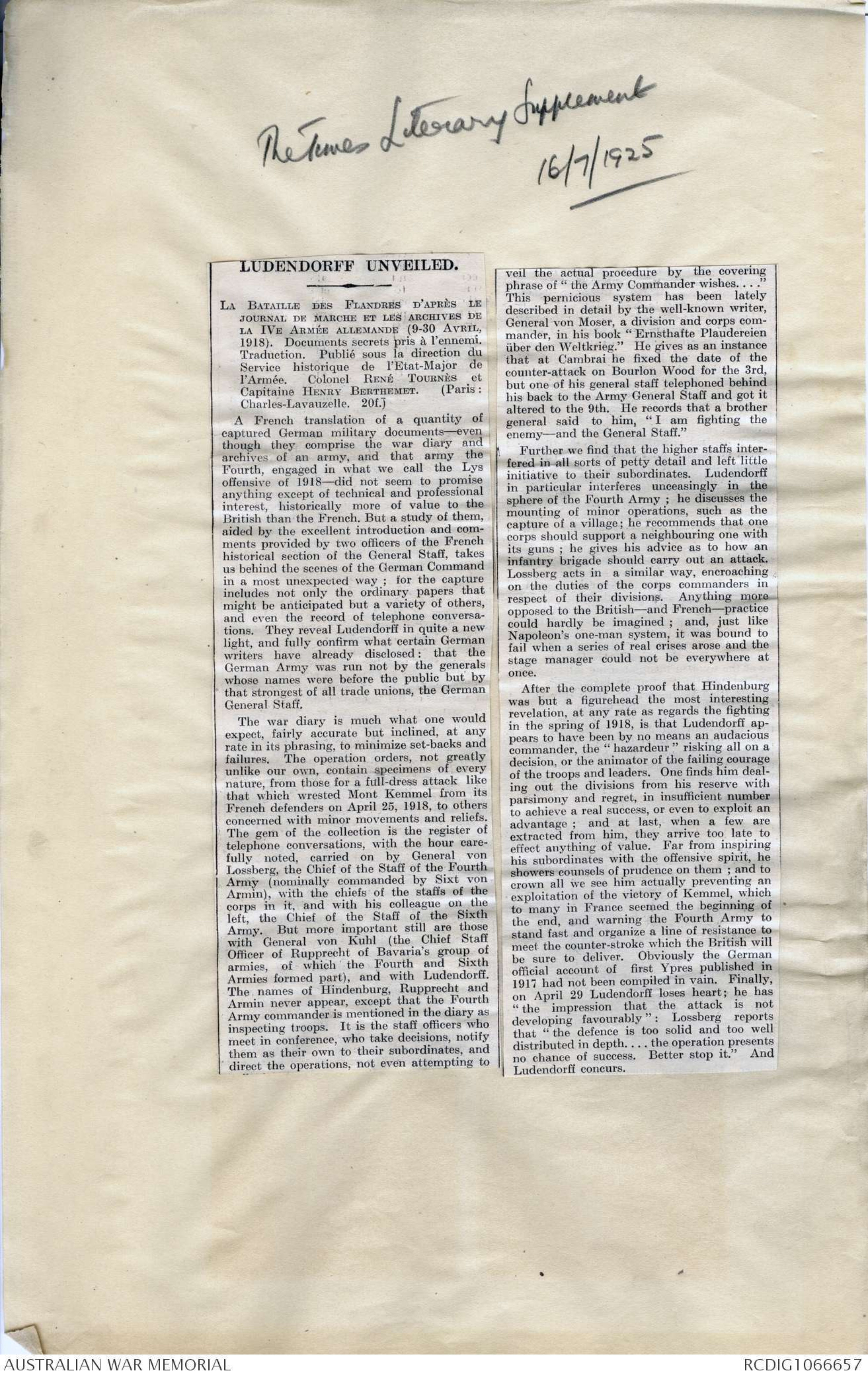
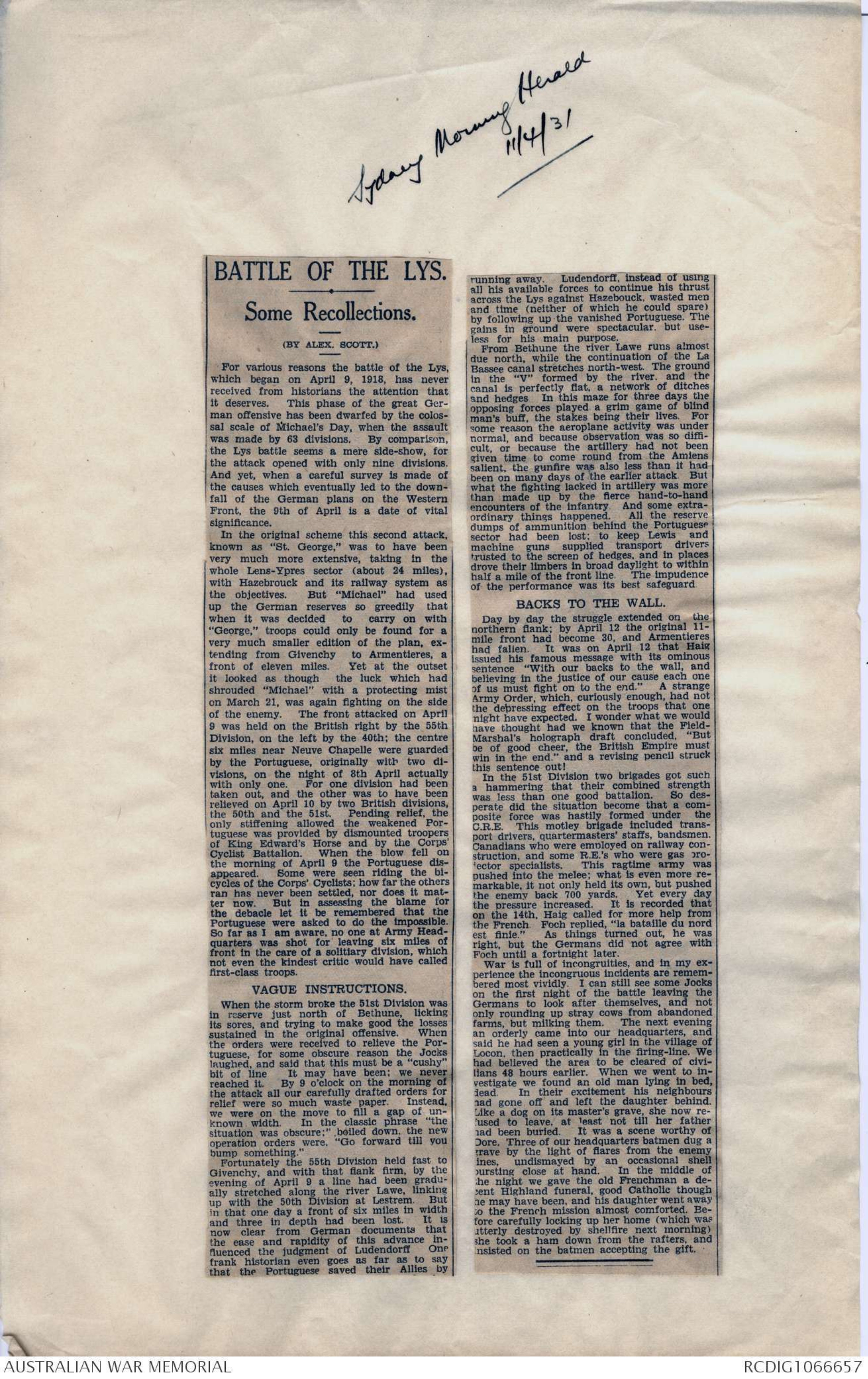
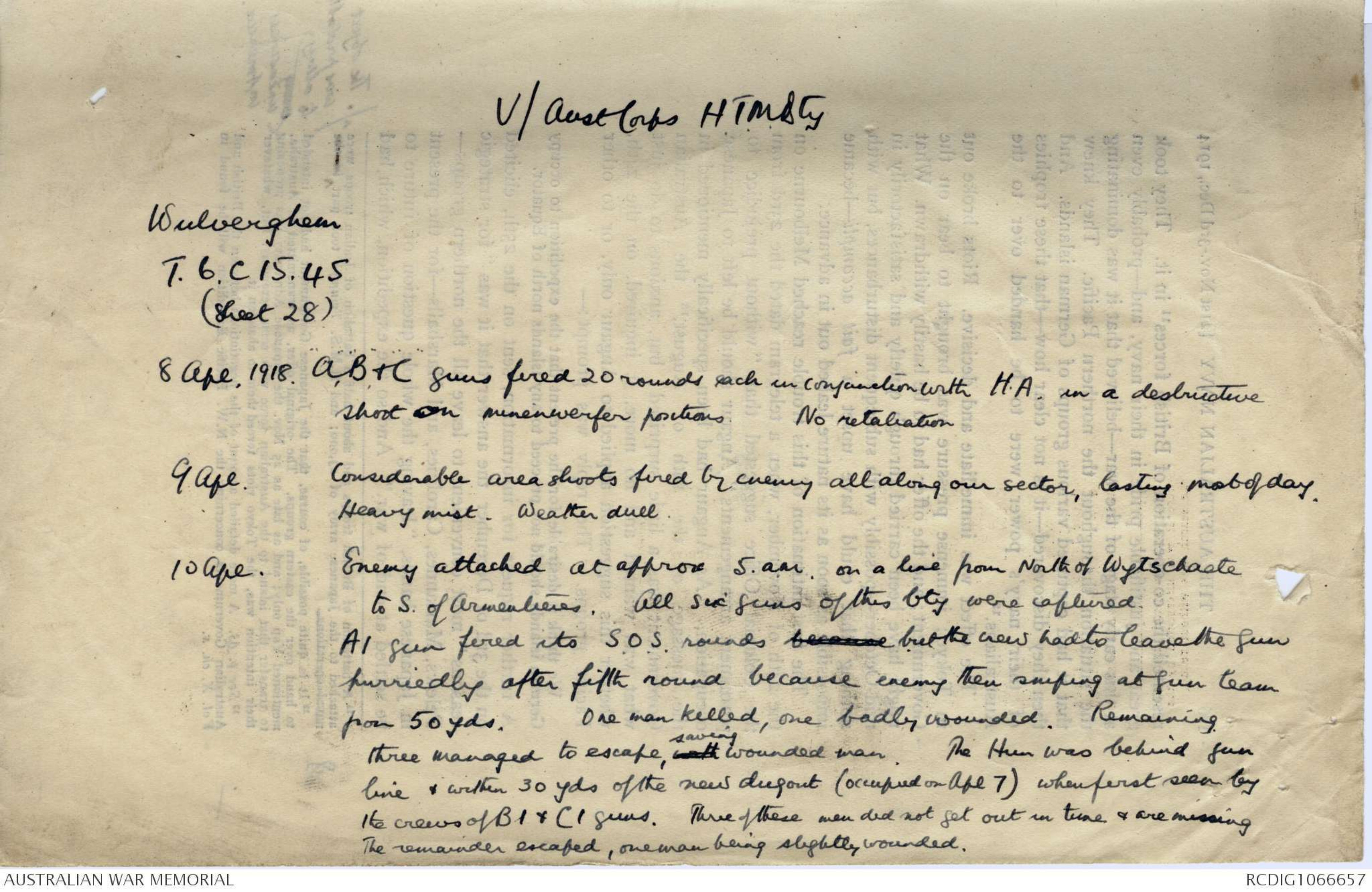
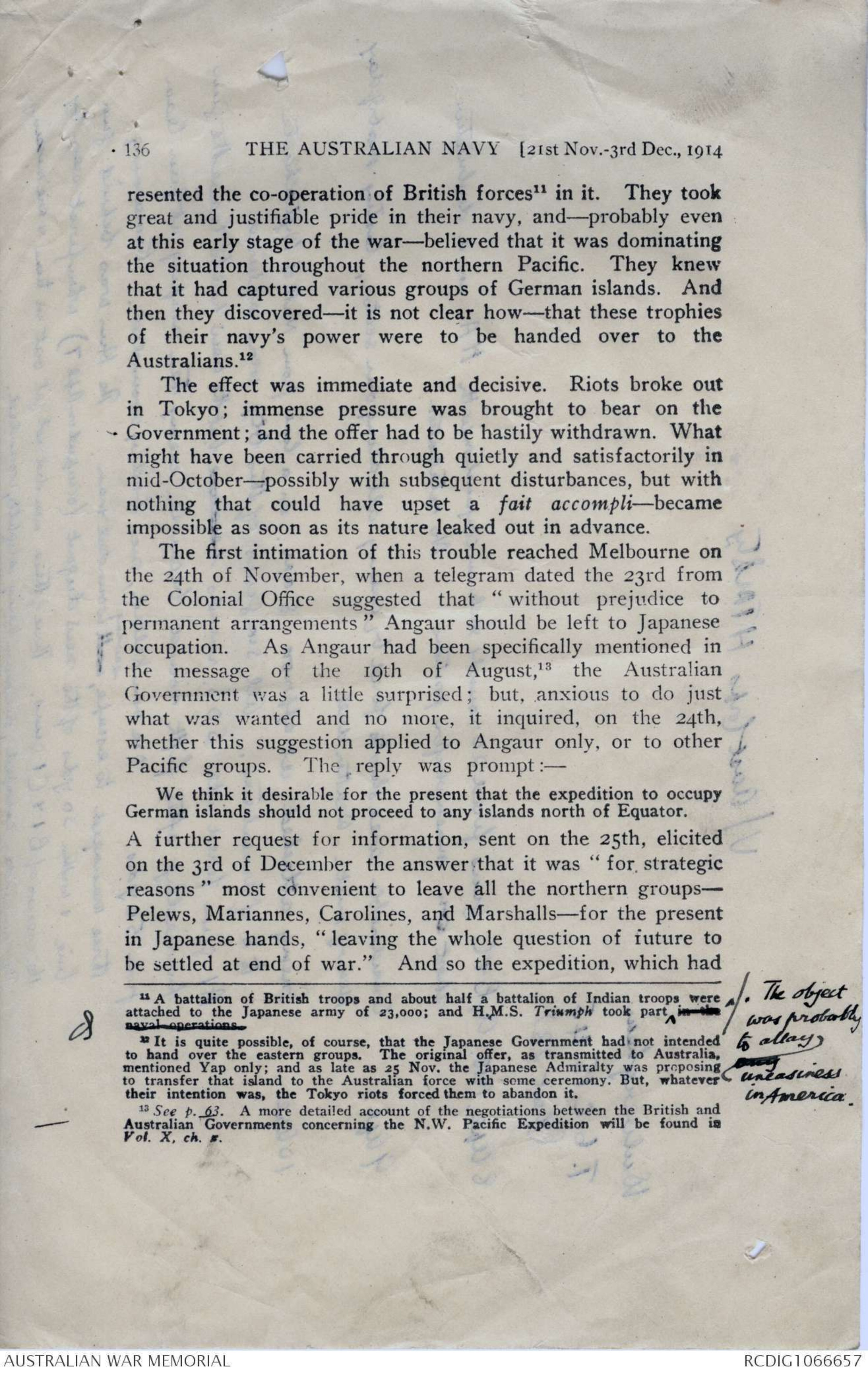
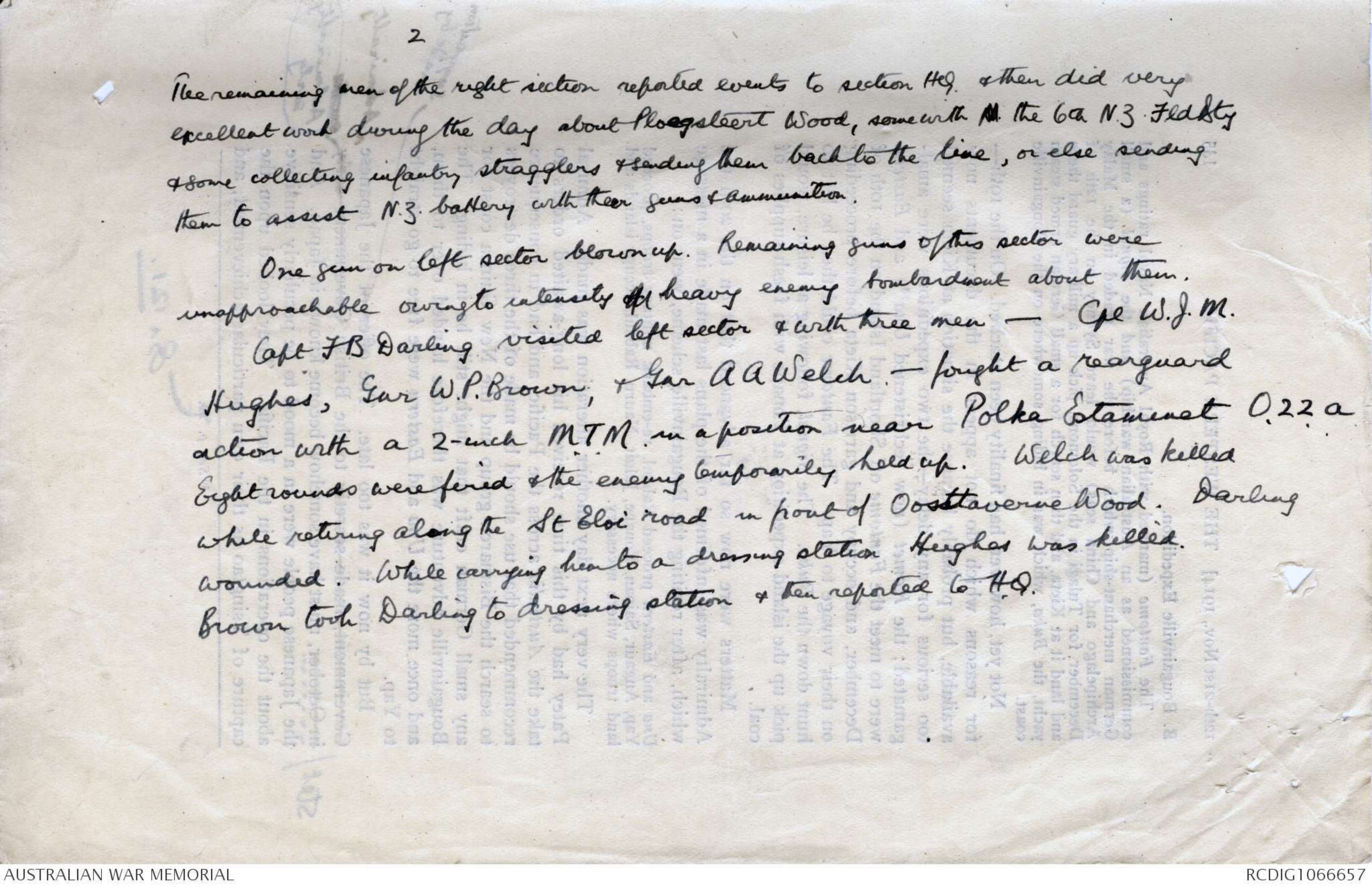

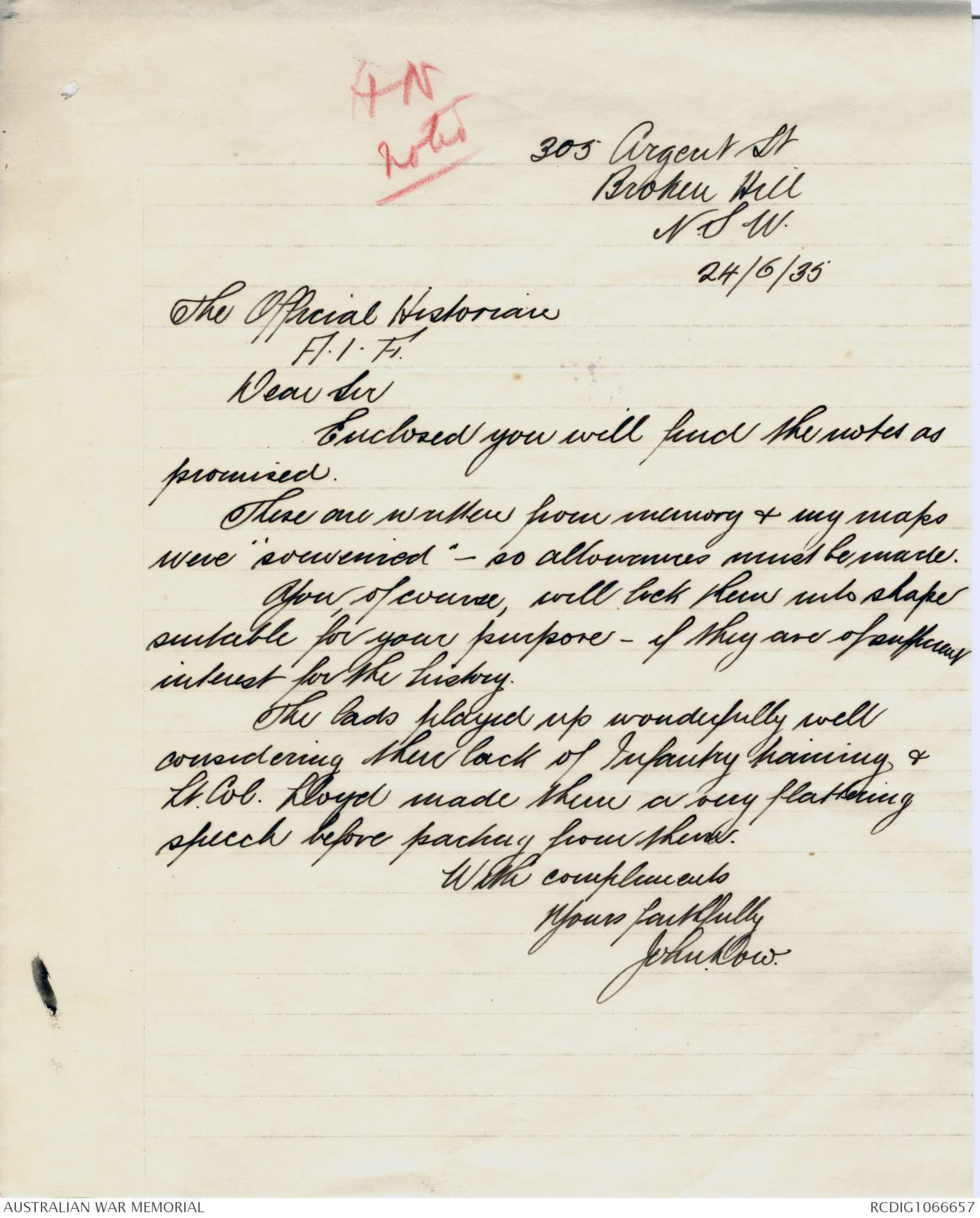
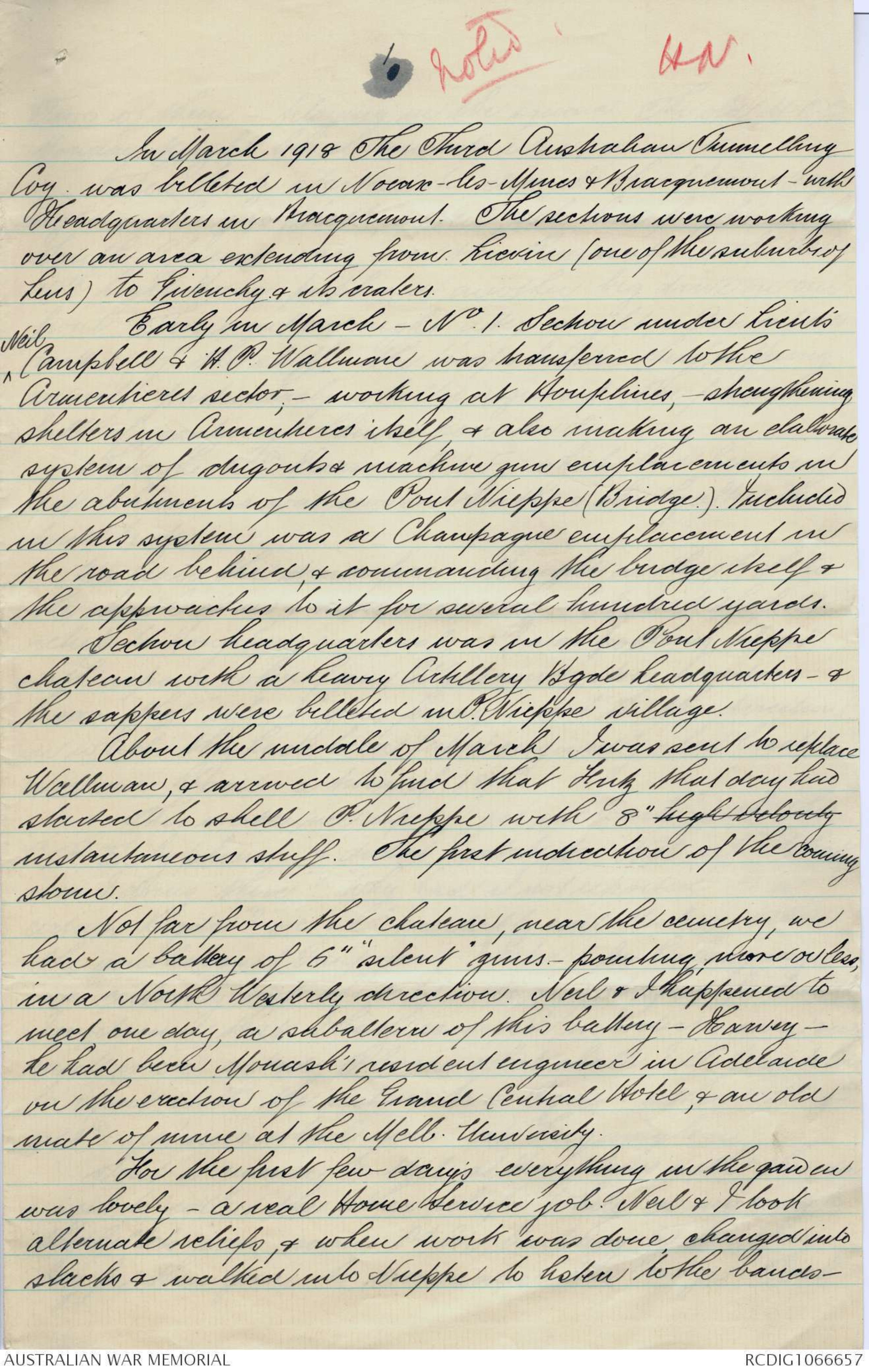
AWM38
Official History,
1914-18 War: Records of C E W Bean,
Official Historian.
Diaries and Notebooks
Item number: 3DR1606/252/1
Title: Folder, 1918- 1935
Comprises various papers on Hazebrouck,
including notes by Bean and A W Bazley, letters
by Lt Col W D Joynt VC, and extracts from the
diary of Pte HG Hartnett.
AWM38-3DRL606/252/1
HAZEBROUCK, 1918. No.252.
1st SET.
AWM 38 3DRL 606 ITEM 252 [1]
DIARIES AND NOTES OF C. E. W. BEAN
CONCERNING THE WAR OF 1914- 1918
THE use of these diaries and notes is subject to conditions laid down in the terms
of gift to the Australian War Memorial. But, apart from those terms, I wish the
following circumstances and considerations to be brought to the notice of every
reader and writer who may use them.
These writings represent only what at the moment of making them I believed to be
true. The diaries were jotted down almost daily with the object of recording what
was then in the writer’s mind. Often he wrote them when very tired and half asleep
also, not infrequently, what he believed to be true was not so —but it does not
follow that he always discovered this, or remembered to correct the mistakes when
discovered. Indeed, he could not always remember that he had written them.
These records should, therefore, be used with great caution, as relating only what
their author, at the time of writing, believed, Further, he cannot, of course, vouch
for the accuracy of statements made to him by others and here recorded. But he
did try to ensure such accuracy by consulting, as far as possible, those who had
seen or otherwise taken part in the events. The constant falsity of second-hand
evidence (on which a large proportion of war stories are founded) was impressed
upon him by the second or third day of the Gallipoli campaign, notwithstanding that
those who passed on such stories usually themselves believed them to be true. All
second-hand evidence herein should be read with this in mind.
C. E. W. BEAN.
16 Sept, 1946.
AUSTRALIAN WAR MEMORIAL
ACCESS STATUS
OPEN
The Times Literary Supplement
16/7/1925
LUDENDORFF UNVEILED.
LA BATAILLE DES FLANDRES D'APRÈS LE
JOURNAL DE MARCHE ET LES ARCHIVES DE
LA IVE WE ARMÉE ALLEMANDE (9-30 AVRIL.
1918). Documents secrets pris à l' ennemi.
Traduction. Publié sous la direction du
Service historique de l'Etat-Major de
l'Armée, Colonel RENÉ TOURNÈS et
Capitaine HENRY BERTHEMET. (Paris:
Charles-Lavauzelle, 20f.)
A French translation of a quantity of
captured German military documents-even
though they comprise the war diary and
archives of an army, and that army the
Fourth, engaged in what we call the Lys
offensive of 1918—did not seem to promise
anything except of technical and professional
interest, historically more of value to the
British than the French. But a study of them,
aided by the excellent introduction and
comments provided by two officers of the French
historical section of the General Staff, takes
us behind the scenes of the German Command
in a most unexpected way; for the capture
includes not only the ordinary papers that
might be anticipated but a variety of others,
and even the record of telephone conversations.
They reveal Ludendorff in quite a new
light, and fully confirm what certain German
writers have already disclosed: that the
German Army was run not by the generals
whose names were before the public but by
that strongest of all trade unions, the German
General Staff.
The war diary is much what one would
expect, fairly accurate but inclined, at any
rate in its phrasing, to minimize set-backs and
failures. The operation orders, not greatly
unlike our own, contain specimens of every
nature, from those for a full-dress attack like
that which wrested Mont Kemmel from its
French defenders on April 25, 1918, to others
concerned with minor movements and reliefs.
The gem of the collection is the register of
telephone conversations, with the hour
carefully noted, carried on by General von
Lossberg, the Chief of the Staff of the Fourth
Army (nominally commanded by Sixt von
Armin), with the chiefs of the staffs of the
corps in it, and with his colleague on the
left, the Chief of the Staff of the Sixth
Army. But more important still are those
with General von Kuhl (the Chief Staff
Officer of Rupprecht of Bavaria's group of
armies, of which the Fourth and Sixth
Armies formed part), and with Ludendorff.
The names of Hindenburg, Rupprecht and
Armin never appear, except that the Fourth
Army commander is mentioned in the diary as
inspecting troops. It is the staff officers who
meet in conference, who take decisions, notify
them as their own to their subordinates, and
direct the operations, not even attempting to
veil the actual procedure by the covering
phrase of "the Army Commander wishes...."
This pernicious system had been lately
described in detail by the well-known writer,
General von Moser, a division and corps
commander, in his book "Ernsthafte Plaudereien
uber den Weltkreig." He gives as an instance
that at Cambrai he fixed the date of the
counter-attack on Bourlon Wood for the 3rd
but one of his general staff telephoned behind
his back to the Army General Staff and got it
altered to the 9th. He records that a brother
general said to him, "I am fighting the
enemy-and the General Staff."
Further we find that the higher staffs
interfered in all sorts of petty detail and left little
initiate to their subordinates. Ludendorff
in particular interferes unceasingly in the
sphere of the Fourth Army; he discusses the
mounting of minor operations; such as the
capture of a village; he recommends that one
corps should support a neighbouring one with
its guns; he gives his advice as to how an
infantry brigade should carry out an attack.
Lossberg acts in a similar way, encroaching,
on the duties of the corps commanders in
respect of their divisions. Anything more
opposed to the British—and French—practice
could hardly be imagined; and, just like
Napoleon’s one-man system, it was bound to
fail when a series of real crises arose and the
stage manager could not be everywhere at
once.
After the complete proof that Hindenburg
was but a figurehead the most interesting
revelation, at any rate as regards the fighting
in the spring of 1918, is that Ludendorff appears
to have been by no means an audacious
commander, the "hazardeur" risking all on a
decision, or the animator of the failing courage
of the troops and leaders. One finds him dealing
out the divisions from his reserve with
parsimony and regret, in insufficient number
to achieve a real success, or even to exploit an
advantage; and at last, when a few are
extracted from him, they arrive too late to
effect anything of value. Far from inspiring
his subordinates with the offensive spirit, he
showers counsels of prudence on them; and to
crown all we see him actually preventing an
exploitation of the victory of Kemmel, which
to many in France seemed the beginning of
the end, and warning the Fourth Army to
stand fast and organize a line of resistance to
meet the counter-stroke which the British will
be sure to deliver. Obviously the German
official account of first Ypres published in
1917 had not been compiled in vain. Finally,
on April 29 Ludendorff loses heart; he has
"the impression that the attack is not
developing favourably" Lossberg reports
that "the defence is too solid and too well
distributed in depth...... the operation presents
no chance of success. Better stop it." And
Ludendorff concurs.
Sydney Morning Herald
11/4/31
BATTLE OF THE LYS
Some Recollections.
(BY ALEX. SCOTT)
For various reasons the battle of the Lys.
which began on April 9, 1918, has never
received from historians the attention that
it deserves. This phase of the great German
offensive has been dwarfed by the colossal a
scale of Michael’s Day, when the assault
was made by 63 divisions. By comparison,
the Lys battle seems a mere side-show, for
the attack opened with only nine divisions.
And yet, when a careful survey is made of
the causes which eventually led to the a
down-fall of the German plans on the Western
Front, the 9th of April is a date of vital
significance.
In the original scheme this second attack,
known as "St. George," was to have been
very much more extensive, taking in the
whole Lens-Ypres sector (about 24 miles),
with Hazebrouck and its railway system as
the objectives. But "Michael" had used
up the German reserves so greedily that
when it was decided to carry on with
"George," troops could only be found for a
very much smaller edition of the plan,
extending from Givenchy to Armentieres, a
front of eleven miles. Yet at the outset
it looked as though the luck which had
shrouded "Michael'’ with a protecting mist
on March 21, was again fighting on the side
of the enemy. The front attacked on April
9 was held on the British right by the 55th
Division, on the left by the 40th; the centre
six miles near Neuve Chapelle were guarded
by the Portuguese, originally with two divisions,
on the night of 8th April actually
with only one. For one division had been
taken out, and the other was to have been
relieved on April 10 by two British divisions,
the 50th and the 51st. Pending relief, the
only stiffening allowed the weakened
Portuguese was provided by dismounted troopers
of King Edward's Horse and by the Corps
Cyclist Battalion. When the blow fell on
the morning of April 9 the Portuguese
disappeared. Some were seen riding the
bicycles of the Corps Cyclists; how far the others
ran has never been settled, nor does it matter
now. But in assessing the blame for
the debacle let it be remembered that the
Portuguese were asked to do the impossible.
So far as I am aware, no one at Army
Headquarters was shot for leaving six miles of
front in the care of a solitiary division, which
not even the kindest critic would have called
first-class troops.
VAGUE INSTRUCTIONS.
When the storm broke the 5lst Division was
in reserve just north of Bethune, licking
its sores, and trying to make good the losses
sustained in the original offensive. When
the orders were received to relieve the
Portuguese, for some obscure reason the Jocks
laughed, and said that this must be a "cushy"
bit of line It may have been: we never
reached it. By 9 o’'clock on the morning of
the attack all our carefully drafted orders for
relief were so much waste paper. Instead,
we were on the move to fill a gap of
unknown width. In the classic phrase "the
situation was obscure" boiled down. the new
operation orders were. "Go forward till you
bump something."
Fortunately the 55th Division held fast to
Givenchy, and with that flank firm, by the
evening of April 9 a line had been gradually
stretched along the river Lawe, linking
up with the 50th Division at Lestrem. But
in that one day a front of six miles in width
and three in depth had been lost.i t is
now clear from German documents that
the case and rapidity of this advance
influenced the judgment of Ludendorff One
frank historian even goes as far as to
that the Portuguese saved their Allies by
running away. LndendorH, instead of using
all his available forces to continue his thrust
across the Lys against Hazebouck, wasted men
and time (neither of which he could spare)
by following up the vanished Portuguese. The
gains in ground were spectacular, but useless
for his main purpose.
From Bethune the river Lawe runs almost
due north, while the continuation of the La
Bassee canal stretches north-west. The ground
in the "V" formed by the river. and the
canal is perfectly fat, a network of ditches
and hedges In this maze for three days the
opposing forces played a grim game of blind
man's buff, the stakes being their lives. For
some reason the aeroplane activity was under
normal, and because observation was so
difficult, or because the artillery had not been
given time to come round from the Amiens
salient, the gunfire was also less than it had
been on many days of the earlier attack But
what the fighting lacked in artillery was more
than made up by the fierce hand-to hand
encounters of the infantry And some
extraordinary things happened. All the reserve
dumps of ammunition behind the Portuguese
sector had been lost: to keep Lewis and
machine guns supplied transport driver.
trusted to the screen of hedges, and in places
drove their limbers in broad daylight to within
half a mile of the front line. The impudence
of the performance was its best safeguard
BACKS TO THE WALL.
Day by day the struggle extended on the
northern flank; by April 12 the original 11-
mile front had become 30, and Armentieres
had fallen. It was on April 12 that Haig
issued his famous message with its ominous
sentence "With our backs to the wall, and
believing in the justice of our cause each one
of us must fight on to the end." A strange
Army Order, which, curiously enough, had not
the depressing effect on the troops that one
night have expected. I wonder what we would
have thought had we known that the Field-
Marshal's holograph draft concluded. "But
be of good cheer, the British Empire must
win in the end" and a revising pencil struck
this sentence out!
In the 51st Division two brigades got such
a hammering that their combined strength
was less than one good battalion. So
desperate did the situation become that a
composite force was hastily formed under the
C.RE. This motley brigade included transport
drivers, quartermasters’ staffs, bandsmen.
Canadians who were employed on railway
construction, and some R.E's who were gas
protector specialists. This ragtime army was
pushed into the melee; what is even more
remarkable, it not only held its own, but pushed
the enemy back 700 yards. Yet every day
the pressure increased. It is recorded that
on the 14th. Haig called for more help from
the French Foch replied, "la bataille du nord
est finie." As things turned out, he was
right, but the Germans did not agree with
Foch until a fortnight later.
War is full of incongruities, and in my
experience the incongruous incidents are
remembered most vividly. I can still see some Jocks
on the first night of the battle leaving the
Germans to look after themselves, and not
only rounding up stray cows from abandoned
farms, but milking them. The next evening
an orderly came into our headquarters, and
said he had seen a young girl in the village of
Locon, then practically in the firing-line. We
had believed the area to be cleared of civilians
48 hours earlier. When we went to investigate
we found an old man lying in bed,
dead. In their excitement his neighbours
had gone off and left the daughter behind.
Like a dog on its master’'s grave, she now r
refused to leave, at least not till her father
had been buried. It was a scene worthy of
Dore. Three of our headquarters batmen dug a
grave by the light of flares from the enemy
lines, undismayed by an occasional shell
bursting close at hand. In the middle of
the night we gave the old Frenchman a
decent Highland funeral, good Catholic though
he may have been, and his daughter went away
to the French mission almost comforted.
Before carefully locking up me (which was
utterly destroyed by shellfire next morning)
she took a ham down from the rafters, and
insisted on the batmen accepting the gift.
V/Aust Corps HTMBty
Wulverghem
T 6.C15. 45
(Sheet 28)
8 Apl. 1918. A.B. &C guns fired 20 rounds eich in conjunction with H.A. in a destructive
shoot on minenwerfer positions No retaliation
9 Apl. Considerable area shoots fired by enemy all along our sector, lasting most of day.
Heavy mist. Weather dull.
10 Apl. Enemy attacked at approx 5. a.m. on a line from North of Wytschaete
to S. of Armentieres. All six guns of this bty were captured.
AI gun fired its S.0.S. rounds because but the crew had to leave the gun
hurriedly after fifth round because enemy then sniping at gun team
from 50yds. One man killed, one badly wounded. Remaining
three managed to escape, with saving wounded man. The Hun was behind gun
line & within 30 yds of the new dugout (occupied on Apl 7) when first seen by
the crews of B1& C1 guns. Three of these men did not get out in time & are missing
The remainder escaped, one man being slightly wounded,
THE AUSTRALIAN NAVY (21st Nov-3rd Dec, 1914
136
resented the co-operation of British forces11 in it. They took
great and justifiable pride in their navy, and -probably even
at this early stage of the war—believed that it was dominating
the situation throughout the northern Pacific. They knew
that it had captured various groups of German islands. And
then they discovered—it is not clear how—that these trophies
of their navy's power were to be handed over to the
Australians.12
The effect was immediate and decisive. Riots broke out
in Tokyo; immense pressure was brought to bear on the
Government; and the offer had to be hastily withdrawn. What
might have been carried through quietly and satisfactorily in
mid-October—possibly with subsequent disturbances, but with
nothing that could have upset a fait accompli—became
impossible as soon as its nature leaked out in advance.
The first intimation of this trouble reached Melbourne on
the 24th of November, when a telegram dated the 23rd from
the Colonial Office suggested that "without prejudice to
permanent arrangements" Angaur should be left to Japanese
occupation. As Angaur had been specifically mentioned in
the message of the 10th of August,13 the Australian
Government was a little surprised; but, anxious to do just
what was wanted and no more, it inquired, on the 24th,
whether this suggestion applied to Angaur only, or to other
Pacific groups. The reply was prompt:-
We think it desirable for the present that the expedition to occupy
German islands should not proceed to any islands north of Equator.
A further request for information, sent on the 25th, elicited
on the 3rd of December the answer that it was "for strategic
reasons" most convenient to leave all the northern groups-
Pelews, Mariannes, Carolines, and Marshalls—for the present
in Japanese hands, "leaving the whole question of future to
be settled at end of war." And so the expedition, which had
11 A Battalion of British troops and about half a battalion of Indian troop;s, were
attached to the Japanese army of 23,000; and H.M.S. Triumph took part,^
[[*The object
was probably
to allay
uneasiness
in America,*]]in the navel operations
12 It is quite possible, of course, that the Japanese Government had not intended
to hand over the eastern groups. The original offer, as transmitted to Australia,
mentioned Yap only; and as late as 25 Nov. the Japanese Admiralty was proposing
to transfer that island to the Australian force with some ceremony. But, whatever
their intention was, the Tokyo riots forced them to abandon it.
13 See p. 63—S. A more detailed account of the negotiations between the British and
Australian Governments concerning the N.W. Pacific Expedition will be found in
Vol. X. ch. s.
2
The remaining men of the right section reported events to section HQ. &then did very excellent work during the day about Ploegsteert Wood, same with A the 6th N.Z. Fld Bty
& some collecting infantry stragglers & sending them back to the line, or else sending
them to assist N.Z. battery with their guns & ammunition,
One gun on left sector blown up. Remaining guns of this sector were
unapproachable owing to intensity of heavy enemy bombardment about them.
Capt FB Darling visited left sector & with three men - Cpl W. J.M.
Hughes, Gun W.P. Brown; & Gun AA Welch - fought a rearguard
action with a 2-inch M.T.M. in a position near Polka Estaminet 0.22.a.
Eight rounds were fired & the enemy temporarily held up. Welch was killed
while returning along the St Eloi road in front of Oosttaverne Wood. Darling
wounded. While carrying hm to a dressing station Hughes was killed.
Brown took Darling to dressing station &f then reported to H.Q..
12th-21st Nov,1914] THE WESTERN PACIFIC
135
B. Bougainville Expedition.
The Fantome (manned with Royal Australian Naval ratings and
commissioned as an Australian warship) and the Signal. (a small
German merchant-ship which before the war traded in the Malay
Archipelago and China seas) would leave Sydney on the 12th of
December for Tulagi in the Solomons, pick up a military guard there
and land it at Kieta, and then search for a small German armed steam
yacht, the Buka, which was in hiding somewhere on the Bougainville
coast.
Not yet, however, had finality been reached. On the 19th—
for reasons which do not appear in the documents now
available, but probably because the situation at Kieta seemed
too serious for any delay—the two expeditions were
amalgamated; the Komet (now rechristened Unat10) and Eastern
were to meet the Fantome off Shortland Island on the 10th of
December, and occupy and garrison Kieta before proceeding
on their voyage to Yap. The Fantome could then be left to
hunt down the Buka. The Signal, following at leisure, would
pick up the island expedition at Ponape with fresh supplies of
coal.
Matters were now so far advanced that on the 20th the
Admiralty was informed of the plans last made in a message
which, after reciting the Bougainville scheme, went on:
Una and Eastern proceed Rabaul, re-embark military troops, proceed
Vap, Angaur, Saipan, Ponape, Jaluit, Nauru, Rabaul, occupy islands and
land troops where necessary.
The very next day another alteration was made. Admiral
Patey had by this time received his long-awaited orders, to
take the Australia across the Pacific, and had in consequence
recommended that use should be made of the three destroyers
to search the Bismarck group and the New Guinea coast for
any small German craft that might still be in hiding. The
Bougainville adventure was therefore handed over to them,
and once more the Una and Eastern were free to go straight
to Yap.
But by now it was too late. The offer of [[*suggestion made by*]] the JapaneseGovernment, made secretly to the British Government early [[*Admiralty early*]]
in October, must have somehow become known in Japan. And
the Japanese people were in a mood to be peculiarly sensitive
about the operations in the Pacific. They looked upon the
capture of Tsingtao as their own particular achievement, and
10 See p. 8^121
HN
noted
305 Argent St
Broken Hill
N.S. W.
24/6/35
The Official Historian
A.I.F.
Dear Sir
Enclosed you will find the notes as
promised.
These are written from memory & my maps
were souvenired - so allowances must be made.
You of course, will lick them into shape
suitable for your purpose - if they are of sufficient
interest for the history.
The lads played up wonderfully well
considering their lack of Infantry training &
Lt. Col. Lloyd made them a very flattering
speech before packing from them.
With compliments
Yours faithfully
John Dow.
noted
HN.
In March 1918 The Third Australian Tunnelling
Coy was billeted in Noeve-les Ypres & Bracquemout - with
Headquarters in Macquemont. The sections were working
over an area extending from Lievin (one of the suburbs of
Lens) to Givenchy & its craters.
Early in March - N. 1. Section under Lieuts
^Neil Campbell & H.P. Wallman was transferred to the
Armentieres sector, - working at Houplines, - strengthening
shelters in Armentieres itself & also making an elaborate
system of dugouts & machine gun emplacements in
the abutments of the Paul Nieppe (Bridge) Included
in this system was a Champagne emplacement in
the road behind, & commanding the bridge itself &
the approaches to it for several hundred yards.
Section headquarters was in the Paul Nieppe
chateau with a heavy Artillery Bgde headquarters- &
the sappers were billeted in P Nieppe village.
About the middle of March I was sent to replace
Wallman, & arrived to find that Fritz that day had
started to shell P. Nieppe with 8" high velocity
instantaneous stuff. The first indication of the coming
show.
Not far from the chateau, near the cemetry, we
had a battery of 6" "silent guns-pointing more or less,
in a North Westerly direction. Neil & I happened to
meet one day, a subaltern of this battery - Harvey.
he had been Monash' resident engineer in Adelaide
on the [[excavation?]] of the Grand Central Hotel & an old
mate of mine at the Melb University.
For the first few day's everything in the garden
was lovely - a real Home Service job Neil & I took
alternate reliefs, & when work was done changed into
slacks + walked into Nieppe to listen to the bands-
 Sam scott
Sam scottThis transcription item is now locked to you for editing. To release the lock either Save your changes or Cancel.
This lock will be automatically released after 60 minutes of inactivity.